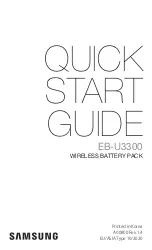
6
7
E CHARGING WHEN BATTERY IS OUTSIDE VEHICLE
A SPARK NEAR THE BATTERY MAY CAUSE BATTERY EXPLOSION.
TO REDUCE RISK OF A SPARK NEAR BATTERY:
Check the polarity of battery posts. A POSITIVE (POS, P+) battery post usually has a
larger diameter than the NEGATIVE (NEG, N–) post. Attach at least 23 inches long/
6-gauge (AWG) insulated battery cable to NEGATIVE (NEG, N–) battery post.
Do not face battery when making the final connection.
Position yourself and the cable’s free end as far away from battery as possible, then
connect the negative (BLACK) charger clip to the cable’s open end.
1. Connect the POSITIVE (red) charger clip to the POSITIVE (POS, P+) post of
the battery.
2. Connect the NEGATIVE (black) charger clip to the NEGATIVE (NEG, N–) post of
the battery.
3. Connect the AC supply cord to the electrical outlet.
4. When disconnecting the charger, do so in reverse order of connecting and
break the first connection while as far away from the battery as possible.
NOTE: A marine battery must be removed and charged on shore. To charge it on
board requires equipment specially designed for marine use.
F CHARGER/MAINTAINER LOCATION
RISK OF EXPLOSION AND CONTACT WITH BATTERY ACID.
1. Position charger as far away from the battery as DC cables permit.
2. Never place a charger directly above the battery being charged. Gases from the
battery will corrode and damage the charger.
3. Never allow battery acid to drip on the charger when reading gravity or filling
the battery.
4. Do not operate charger in a closed area or restrict ventilation in any way.
G SETTING UP AND OPERATION
WARNING: DO NOT CHARGE BATTERY TYPES OUTSIDE
OF THE CHARGER’S WORKING CAPABILITY.
BATTERY MAINTAINER SETTINGS
Plug the AC power cord into an AC power source. All LEDs will light momentarily,
then only the LEDs corresponding to charging settings should stay lit. The charger is
in Standby Mode now.
If the ERROR LED lights, disconnect it from the AC power source immediately and
find the error reason.
CHARGE A BATTERY
1. Choose a battery voltage charge setting.
The default setting is the 12V mode, which will apply to most charging
applications. To charge in 6V mode, push the charge setting button until the
“6V” LED is lit.
2. Choose a battery type setting.
To charge standard and maintenance free flooded-acid batteries, push the
Battery Type button until the “STD” LED is on.
To charge AGM and spiral wound batteries, push the Battery Type button
until the “AGM” LED is lit. To charge a LiFePO4 battery, push the Battery Type
button until the “LiFePO4” LED is lit.
3. Press the “START” and the charging LED will light.
The charger will automatically start and complete the charging process.
NOTE: If the battery’s open-circuit voltage is lower than 1V, the charger will indicate
a fault. Please unplug the charger, check connections and verify all settings if they
are correct. After checking, if you determine the problem is just the battery voltage
lower than 1V, you can ignore the charger’s protection by pressing the “START”
button directly for 3 seconds. The charger will restart the charging process and
assume there are no other problems that caused the fault. The charger will complete
the charging process and turn off when the battery has been fully charged.
1
2
3
Choose battery voltage
Choose battery type
Start/Stop charging























